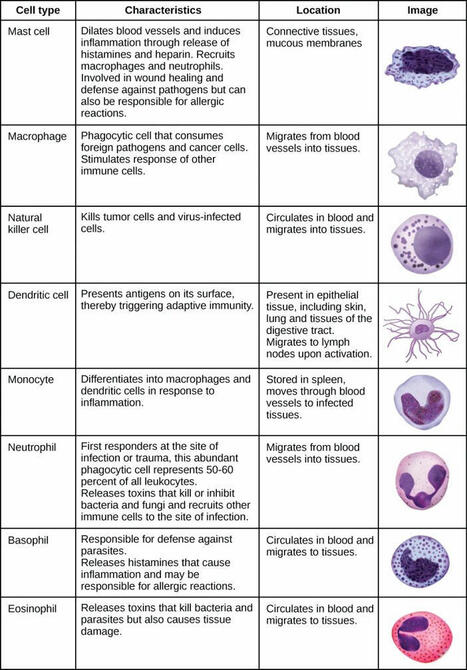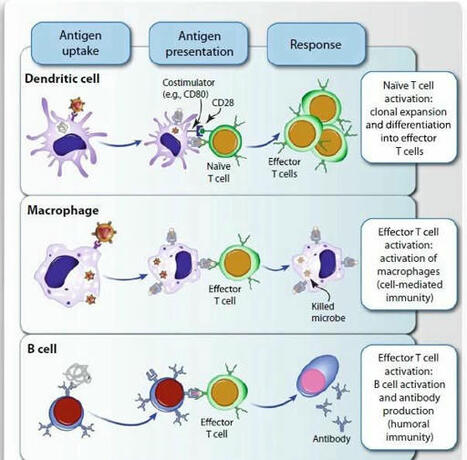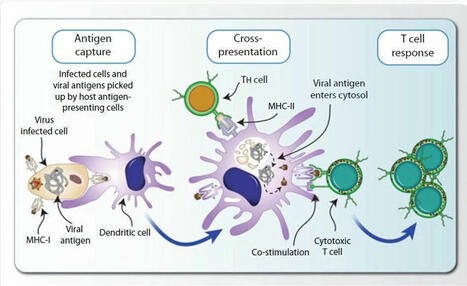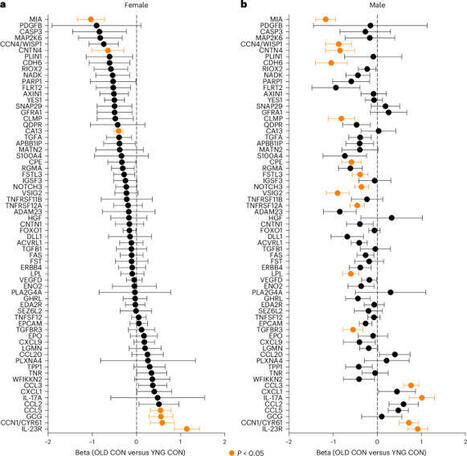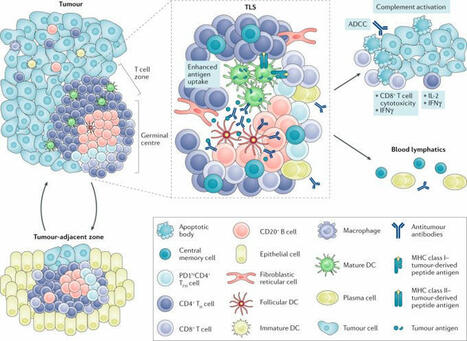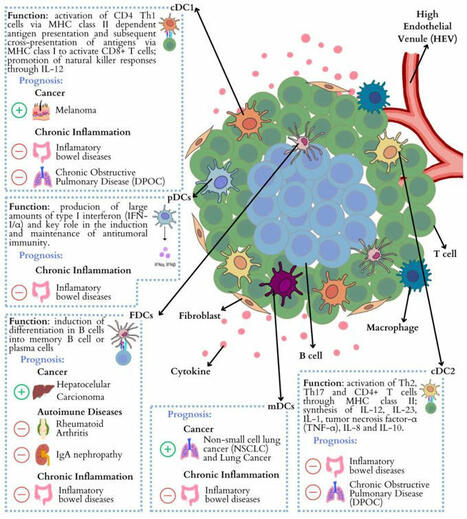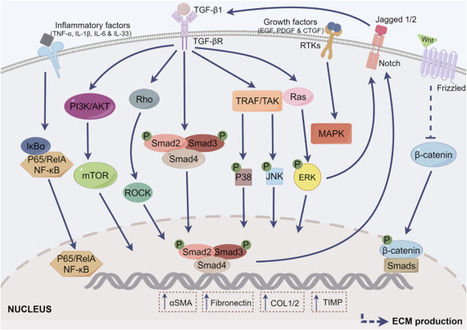 Your new post is loading...
 Your new post is loading...

|
Scooped by
Gilbert C FAURE
January 5, 4:59 AM
|
𝗧𝗬𝗣𝗘𝗦 𝗢𝗙 𝗜𝗠𝗠𝗨𝗡𝗘 𝗖𝗘𝗟𝗟𝗦 𝗔𝗡𝗗 𝗧𝗛𝗘𝗜𝗥 𝗙𝗨𝗡𝗖𝗧𝗜𝗢𝗡𝗦
1. Mast Cell
🔵 Dilates blood vessels.
🔵 Induces inflammation via… | 14 comments on LinkedIn

|
Scooped by
Gilbert C FAURE
December 31, 2024 3:59 AM
|
🌟 The Unsung Heroes of the Immune System: Antigen-Presenting Cells (APCs) 🌟
Our immune system is a masterpiece of coordination, with Antigen-Presenting…

|
Scooped by
Gilbert C FAURE
December 31, 2024 3:57 AM
|
🛡️ Cross-Presentation: A Key to Unlocking Cytotoxic T Cell Responses
🔍 What is Cross-Presentation?
Cross-presentation is a unique immunological process…

|
Scooped by
Gilbert C FAURE
December 23, 2024 1:06 PM
|

|
Scooped by
Gilbert C FAURE
December 22, 2024 10:53 AM
|

|
Scooped by
Gilbert C FAURE
December 14, 2024 5:22 AM
|
Cellular senescence is an aging mechanism characterized by cell cycle arrest and a senescence-associated secretory phenotype (SASP). Preclinical studies demonstrate that senolytic drugs, which target survival pathways in senescent cells, can counteract age-associated conditions that span several organs. The comparative efficacy of distinct senolytic drugs for modifying aging and senescence biomarkers in vivo has not been demonstrated. Here, we established aging- and senescence-related plasma proteins and tissue transcripts that changed in old versus young female and male mice. We investigated responsivity to acute treatment with venetoclax, navitoclax, fisetin or luteolin versus transgenic senescent cell clearance in aged p16-InkAttac mice. We discovered that age-dependent changes in plasma proteins, including IL-23R, CCL5 and CA13, were reversed by senotherapeutics, which corresponded to expression differences in tissues, particularly in the kidney. In plasma from humans across the lifespan, IL-23R increased with age. Our results reveal circulating factors as candidate mediators of senescence-associated interorgan signal transduction and translationally impactful biomarkers of systemic senescent cell burden. Using mouse and human plasma, Carver et al. identify factors that are altered with age and test which are reverted by a panel of genetic and pharmacological senolytic interventions in aged mice. They identify IL-23R as a senescence-associated, age-increased circulating biomarker.

|
Scooped by
Gilbert C FAURE
December 12, 2024 3:34 AM
|

|
Scooped by
Gilbert C FAURE
December 5, 2024 8:48 AM
|

|
Scooped by
Gilbert C FAURE
December 5, 2024 4:03 AM
|

|
Scooped by
Gilbert C FAURE
December 2, 2024 9:45 AM
|
As a pivotal cytokine, IL-22 plays a crucial role in the pathogenesis of autoimmune diseases. In this comprehensive review, we initially provide an overvie

|
Scooped by
Gilbert C FAURE
November 20, 2024 1:21 PM
|

|
Scooped by
Gilbert C FAURE
October 11, 2024 11:14 AM
|

|
Scooped by
Gilbert C FAURE
September 19, 2024 4:31 AM
|
The extent of central T cell tolerance is determined by the diversity of self-antigens that developing thymocytes ‘see’ on thymic antigen-presenting cells (APCs). Here, focusing on insights from the past decade, we review the functional adaptations of medullary thymic epithelial cells, thymic dendritic cells and thymic B cells for the purpose of tolerance induction. Their distinct cellular characteristics range from unconventional phenomena, such as promiscuous gene expression or mimicry of peripheral cell types, to strategic positioning in distinct microenvironments and divergent propensities to preferentially access endogenous or exogenous antigen pools. We also discuss how ‘tonic’ inflammatory signals in the thymic microenvironment may extend the intrathymically visible ‘self’ to include autoantigens that are otherwise associated with highly immunogenic peripheral environments. For effective central T cell tolerance, developing thymocytes must encounter a diverse range of self-antigens presented by various thymic cells. Here, the authors describe how medullary thymic epithelial cells, dendritic cells and B cells are uniquely adapted through promiscuous gene expression, strategic positioning and inflammatory signals, which shape the peptide–MHC ligandomes and extend self-antigen visibility in the thymic microenvironment.
|

|
Scooped by
Gilbert C FAURE
December 31, 2024 4:03 AM
|
SLAMF7: Unlocking the Potential of T Memory Stem Cells for the New Year
T memory stem cells (T_SCM) have redefined immunology, overturning the long-held…

|
Scooped by
Gilbert C FAURE
December 31, 2024 3:58 AM
|
Breaking Study | #DendriticCells #Type1 control the formation, maintenance, & function of #TertiaryLymphoidStructures in #Cancer | Targeting of #cDC1s to…

|
Scooped by
Gilbert C FAURE
December 31, 2024 3:56 AM
|
The Immune Synapse: Key to T Cell Activation and Immune Response ⚔️🧬
The immune synapse is a critical structure that enables T cells to communicate…

|
Scooped by
Gilbert C FAURE
December 23, 2024 4:54 AM
|
𝐓𝐡𝐞 𝐈𝐦𝐦𝐮𝐧𝐞 𝐒𝐲𝐬𝐭𝐞𝐦: 𝐀 𝐂𝐨𝐦𝐩𝐫𝐞𝐡𝐞𝐧𝐬𝐢𝐯𝐞 𝐎𝐯𝐞𝐫𝐯𝐢𝐞𝐰
Innate Immunity: This section highlights the body's first line of defense… | 12 comments on LinkedIn

|
Scooped by
Gilbert C FAURE
December 18, 2024 1:04 PM
|

|
Scooped by
Gilbert C FAURE
December 12, 2024 3:36 AM
|

|
Scooped by
Gilbert C FAURE
December 7, 2024 12:45 PM
|
#Immunotherapy | Role of #DendriticCells in #TertiaryLymphoidStructures | Implications for #Cancer and #AutoImmuneDiseases | OPEN ACCESS Review from Mariana…

|
Scooped by
Gilbert C FAURE
December 5, 2024 4:06 AM
|
Fibrosis, an excessive self-repair response, is an age-related pathological process that universally affects various major organs such as the heart, liver, kidney, and lungs. Continuous accumulation of pathological tissue fibrosis destroys structural integrity and causes loss of function, with...

|
Scooped by
Gilbert C FAURE
December 4, 2024 10:19 AM
|

|
Scooped by
Gilbert C FAURE
November 29, 2024 9:56 AM
|

|
Scooped by
Gilbert C FAURE
November 7, 2024 12:24 PM
|

|
Scooped by
Gilbert C FAURE
September 28, 2024 4:12 AM
|
An enduring antibody response is ultimately dependent on the generation and maintenance of long-lived plasma cells. New research describes the use of single-cell transcriptomics approaches to reveal the defining features of longevity in plasma cells.
|
 Your new post is loading...
Your new post is loading...
 Your new post is loading...
Your new post is loading...




